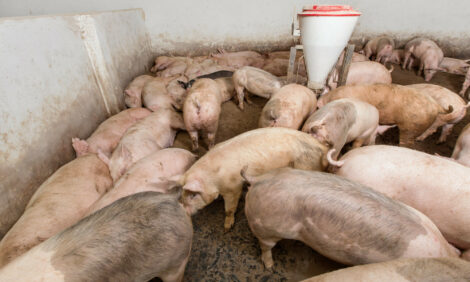



Orego-Stim and Post-Weaning Diarrhoea Syndrome
A review of the efficacy of Orego-Stim against post-weaning diarrhoea in Technical Bulletin No. 11 from Meriden Animal Health.Introduction
Post-weaning diarrhoea syndrome (PWDS) of piglets is caused mainly by enterotoxigenic Escherichia coli (ETEC) strains. PWDS is an entity of the pig industry induced by stress factors occurring at the early weaning and further complicated by opportunistic secondary pathogens. Some examples of these stressors are separation from the sow, mixing with other pigs, a lack of lactogenic immunity (colostrum) and changes to their environment and diet.
 |
In earlier days, PWDS was mainly regarded as a disease with Escherichia coli as the monocausal agent. Nowadays, PWDS is regarded as a multi-factorial problem, where management, feed composition, hygiene and other factors play an important role in the expression of the disease.
An important aspect of gut resistance towards PWDS is a diverse and stable microbiota, by which competitive exclusion is generated, counteracting against the growth and attachment of pathogenic bacteria. When weaning occurs at three to four weeks of age, the development of the piglet’s gut is still too immature to digest a plant-based diet and the normal gut morphology is disturbed by stress, infection and a low feed intake. These processes result in damage to the gut, which may be caused by a reduction in feed intake or an increased susceptibility to infections such as rotavirus.
The maldigestion and malabsorption that follows further increases the amount of undigested substrate in the ileum, which may cause an explosive growth of bacteria and a disturbance of gut microbiota. As a result, the gut colonisation resistance is lowered and the normally transient E. coli strains in the gut can now proliferate and attach to the enterocytes, reducing the height of villi and increasing crypt depth.
The enterotoxins produced by the different types of E. coli are responsible for the symptoms of PWDS such as watery diarrhoea, enteritis and dehydration, which may eventually lead to death if left untreated. The diarrhoea is usually transient, but will inevitably result in a loss of body condition and poor performance, which further translates to significant economic losses for the producer.
The various factors which trigger PWDS are summarized in Figure 1 below:

How Orego-Stim® Can Help
Orego-Stim is a natural, phytogenic feed additive and continues to be the market leader amongst all other essential oils in the livestock industry.
Orego-Stim controls and prevents PWDS via the following mechanisms:
A) Orego-Stim controls infection
Extensive in vitro and in vivo trials have proven that Orego-Stim assists in alleviating problems associated with the presence of E. coli and other gastrointestinal pathogens. The essential oil within Orego-Stim consists predominantly of a unique ratio and concentration of the natural phenolic compounds, carvacrol and thymol, which are known to be powerful antimicrobial agents. Phenols kill bacteria such as E. coli through its toxic effect on the cell wall, by denaturing and coagulating the proteins within the cell wall structure. The increase in permeability causes leakage of cellular constituents, resulting in water imbalance and cell death.
The absence of pathogenic bacteria from the gastrointestinal tract results in a healthy intestine, with optimal growth of villi within the intestines. The longer villi provide a greater surface area for maximum absorption of nutrients. This leads to improvements in growth rates and feed conversion efficiency, while saving on feed costs, as energy and other nutrients from the feed are fully utilised for the process of growth and maintenance.
There have also been numerous studies of E. coli which have developed resistance to a vast array of antibiotics such as chloramphenicol, oxytetracycline, streptomycin and sulphonamide drugs. In contrast to antibiotics and antibiotic growth promoters, there has been no evidence of development of bacterial resistance from using Orego-Stim simply because its inhibitory effect on bacteria is due to its phenolic mode of action, which is by direct contact.
B) Orego-Stim promotes a balanced microbiota
A normal and healthy intestine usually consists of more than 99 per cent of beneficial or non-pathogenic microorganisms. In clinical occurrences of diarrhoea, the population of these microorganisms usually drop to about 97 per cent of the intestinal population, and three per cent are taken over by pathogens through the process of competitive exclusion.
It is known that beneficial and pathogenic bacteria co-exist within the gastrointestinal tract in an inverse relationship that is ruled by competitive exclusion. When an animal undergoes a period of stress or disease challenge, the population of beneficial bacteria takes a dip, and this allows the opportunistic pathogens to increase in numbers to a certain threshold which then causes the clinical signs of intestinal disease, which is usually manifested by occurrences of diarrhoea.
Based upon results of in vitro tests, Orego-Stim has a higher killing affinity towards pathogenic bacteria such as E. coli compared to beneficial microbes such as Bifidobacterium and Lactobacillus. So even if Orego-Stim selectively kills what may seem like only a small percentage of pathogenic bacteria in comparison to beneficial bacteria, it actually represents a large percentage of pathogen reduction and this improves the balance of gut microbiota by ensuring that pathogen numbers are kept to a check and the reestablishment of beneficial bacteria within the gut takes place via competitive exclusion. Continuous use of Orego-Stim will thus ensure that the numbers of pathogens are kept at the lowest possible levels, while maintaining and preserving healthy levels of beneficial bacteria populations in the intestines.
C) Orego-Stim increases feed intake
The sense of taste and smell allow animals to separate undesirable or even lethal foods from those that are nutritious. Physiologically, stimulation of smell and taste acts as a preparatory factor for starting off feed consumption, contributing to the generation of the sense of appetite. Under intensive animal husbandry conditions, the aim to achieve high production rates is closely related to an increased feed intake. Appetisers are used for this very purpose, as they make feed more desirable for animals to consume. The phenolic compounds within Orego-Stim give it a unique and aromatic flavour. All the different phenols found in Orego-Stim are aromatic hydrocarbons, which are responsible for its characteristic smell and taste.
Phenols are well-known as aromatic substances that are commonly used for food flavouring. Orego-Stim, which contains a natural mixture of different phenols, can be used as an appetiser in livestock feeds to enhance its palatability. The phenols within Orego-Stim stimulate the olfactory cells in the nasal cavity and the taste buds and other sensual receptors in the oral cavity, which then trigger the olfactory and glossopharyngeal pathways of the cranial nerves to provoke a feeling of hunger, an increase in salivation and an improvement in appetite. This stimulation also kick-starts the process of digestion by inducing secretion of digestive enzymes in the gastrointestinal tract. As a result, there is an increase in feed intake, as the animal starts to consume more food.
Due to its appetite-enhancing effects, Orego-Stim stimulates higher feed consumption when fed to post weaning piglets. The increased feed intake results in better daily weight gain, better uniformity of body weight at weaning and also higher survivability rates at weaning.
Efficacy Trial Against PWDS
A trial was carried out in a commercial pig farm in Greece with a previous history of PWDS, caused mainly by ETEC. The farm was free of transmissible gastroenteritis, porcine epidemic diarrhoea and other diarrhoea-causing factors.
At the weaning age of 25 (± 3 days of age), a total of 108 healthy piglets of the same genetic background were individually marked with ear tags, weighed and divided into nine pens. A randomised block design was used with three treatments and three replicate pens of 12 pigs each with similar average liveweight, weight range (P>0.05) and equal sex ratio per treatment. The total trial period was 21 days. During the first seven days of the trial, all groups received feed free of any antimicrobial agent, organic acid or performance enhancer. From day 8 up to the end of the trial, three of the treatments received the following feed:
T1: Negative Control – feed free of any antimicrobial agent/organic acid/performance enhancer
T2: Orego-Stim at 250g per tonne of feed
T3: Orego-Stim at 500g per tonne of feed
Results are displayed in Tables 1 to 4 below:

The two treatment groups receiving Orego-Stim showed significantly lower mortality, reduced incidence and severity of diarrhoea in weaned pigs, increase in average daily weight gain as well as an improved FCR compared to the negative control group.
This trial proves that Orego-Stim is effective in the control of PWDS while ensuring good growth performance, and thus proves the possibility of PWDS control without the use of classical antibacterials.
Summary
Orego-Stim has not only been proven to be successful in the control and prevention of PWDS, but also improves the performance of post weaning piglets in terms of feed intake, weight gain, feed conversion and the prevention of other diseases or factors that cause diarrhoea in pigs. With the proper and continuous usage of Orego-Stim in conjunction with a good herd health management programme, PWDS should and would eventually become a disease of the past, as producers no longer need to turn to growth promoter antibiotics to control or prevent the occurrence of such diseases on the farm.
July 2011







